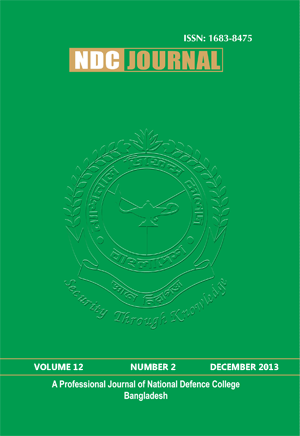“THE FALL OF LTTE”- IMPLICATIONS FOR NATIONAL, REGIONAL AND INTERNATIONAL SECURITY
Keywords:
SECURITYAbstract
The Liberation Tigers of Tamil Eelam (LTTE), also known as the Tamil Tigers, are a separatist group in Sri Lanka agitating for a homeland for ethnic Tamils for last three decades causing death of over 80 000 Sri Lankans of all ethnicities. Considering the threat to the lives of its citizen, the history of atrocities inflicted on its people, and the LTTE’s repeated violations of the ceasefire agreement, Sri Lankan government had no resort but to order its military to liberate the people of the North and East from LTTE control and free all Sri Lankans from the LTTE’s terror. After three years of fearsome fighting On 18 May 2009, Sri Lankan armed forces defeated the LTTE, bringing an end to the three decades of conflict and suffering.
Today, Sri Lankans of all ethnicities, living in all parts of Sri Lanka, are free from LTTE terror and no longer lives in a state of fear. Democracy is restored in the North and the East, the electoral process has been resuscitated after decades, internally displaced persons have been resettled in their homes, infrastructure is being restored, former armed groups have been disarmed and have joined the political process, child soldiers conscripted by the LTTE are back with their families, and other cadres who surrendered are being reintegrated into civilian life after rehabilitation. Sri Lankans have begun the process of rebuilding their country.
Although, the LTTE is militarily defeated in Sri Lanka, its international networks with the backing of Tamil Diaspora are still active and even formed a provisional trans-national government of Tamil Eelam which they famously called as government in exile. The aim of the LTTE’s international network is to re-organize the group and commence their brutal war again to pursue their ideology of bifurcation of Sri Lanka to create a separate home land for Tamil speaking people. Success of such terror group not only threatens the stability and security of Sri Lanka but the region and world at large. The insurgents groups having transnational networks cannot be fought by domestic governments without a transnational capability and capacity. Thus, the nation states should be united to prevent resurgence of this kind of terrorist organizations. The traditional roles of defence and foreign affairs establishments deliberate for deterrence and bilateral relations do not have the institutional mechanisms to meet the threat posed by 21 centaury terrorism. Therefore, an integrated, multipronged and a transnational strategy is the key to address today’s National, Regional and International security dimensions.
Downloads
References
Dixit, J.N., Assignment Colombo, Konark Publications, Delhi, 1998.
Gunaratna Rohan., 1993. Indian Intervention in Sri Lanka, Colombo: South Asian Network on Conflict Research.
Gunaratna, Rohan., 1997. International and Regional security implications of the Sri Lankan Tamil Insurgency. Colombo: Alumni Association of the Bandaranayke Center for international studies Sri Lanka.
Hewitt, Vernon., 1997. The new international politics of South Asia, Manchester: Manchester University press.
Hoole, Rajan.,Somasundram, Daya., Siritharan,K. & Thiranagama, Rajini., 1992. The Broken Palmyra – The Tamil crisis in Sri Lanka: An inside Account. Claremont, CA: The Sri Lankan Studies Institute.
Jamwal, NS., Counter Terrorism Strategy, Strategic Analysis, Vol. 27, No. 1, Jan-Mar 2003, New Delhi: Institute for Defence Studies and Analyses.
Kadian, R., 1980. India’s Sri Lanka Fiasco, New Delhi: Vision Books.
Peiris, G.H., 2001 “Clandestine Transactions of the LTTE and the Secessionist Campaign in Sri Lanka”, Ethnic Studies Report, (bi-annual journal of the International Centre for Ethnic Studies, Sri Lanka.
Rajasingham, Senanayake Darini., From National Security State to Human Security: The Challenge of Winning the Peace in Sri Lanka, ISAS Working Paper No. 72 – Date: 9 July 2009 Institute of south Asian studies, National university of Singapore.
Sankaran, Krishna., 2001. India’s Role in Sri Lanka’s Ethnic Conflict, Colombo: Marga Institute.
Seevaratnam, N., 1989 The Tamil National Question and the Indo Sri Lanka Peace Accord, Delhi: Konark Publications.
Singh, Depinder., The IPKF in Sri Lanka, Trishul Publishers, New Delhi, 1992.
Sumantra Bose., 1994. States, Nations, Sovereignty, Sri Lanka, India and the Tamil Eelam Movement, New Delhi: Sage Publications.
Swamy, Narayan., 1994. Tigers of Lanka: From Boys to Guerrillas, Delhi.
Tekwani, Shyam., The LTTE’s online network and its implications for Regional security, January 2006, Paper No.104, Institute of Defence and Strategic Studies, Singapore available at www.rsis.edu.sg/publications/ WorkingPapers/WP104.pdf.
Davis, Anthony., “Tracking Tigers in Phuket”, Asia week, 16 June 2000
Jamwal, N.S., Counter Terrorism Strategy, Institute for Defence Studies and Analyses, IDSA Journal Vol 27 Issue 1 (January 2003), New Delhi
Jane’s spells out LTTE s annual income available at http://lrrp2.wordpress. com/2008/08/12/jane-s-spells-out-ltte-s-annual-income/
Maylivaganan, M., Re-emergence of the Tamil Nadu Factor in India’s Sri Lanka Policy, IDSA Journal Vol. 31, Issue 6 (November 2007)
Chalk, Peter., ‘LTTE’s International Organization and Operations – A Preliminary Analysis’, A Canadian Security Intelligence Service publication dated March 17, 2000, Commentary No. 77
Gunaratna R., 1993. Indian Intervention In Sri Lanka, Colombo:South Asian Network on Conflict Research.
Humanitarian operation factual analysis July 2006 – may 2009, published by Ministry of Defence, Democratic Socialist Republic of Sri Lanka, July 2011.
Indian Air force Operation Poomalai available at http://www.bharat-rakshak. com/IAF/History/1987IPKF/1022-Chapter01.html
International Crisis Group Asia Report N°206, 23 June 2011, India and Sri Lanka after the LTTE.
Karim, Maj. Gen. A., 1993.Transnational Terrorism- The Danger In The South. New Delhi: Lancer paper.
Kartha, Tara., “Proliferation and smuggling of weapons and narcotics in South Asia”, (IDSA 2000)
Kartha, Tara., “Trans- National Crime and Light Weapons Proliferation”, IDSA Strategic Analysis (December 1999): 1452.
Manoharan, Dr. N., Taming the Tigers: Factors behind LTTE’s Military Downfall. Article No.1270, Centre for Land Warfare Studies Site. Available at http: //www. claws.in [accessed on 20 April 2012].
O’balance, Edgar., The Cyanide War. Asian Security 1989-90.
Singh, Amit Kumar., .The Rising Tide of Left Wing Extremism in India. Manekshaw Paper No. 8, 2008. New Delhi: Centre for Land Warfare Studies (CLAWS),
Wanasundara, Hon. R.S., Sinhala Commission.17 September 1997.
Abeyratne, Dr. Ruwantissa., Role of SAARC in combating terrorism, ensuring regional peace. Daily News 04 December 2008, on line.
Advani,”PWG has Links With LTTE:, The Hindu, October 6, 2003 New Delhi.
Anon, 1995. “Funding Terror: The Liberation Tigers of Tamil Eelam and their Criminal Activities in the Western World”, Toronto.
Davis, A., “A secret Tamil guerrilla bares embracers Bangkok”. Bangkok Post, 15 Jun 2000.
Ekram, Kabir., “Is Colombo Alone?” The Daily Star 23 June 2000.
Ikram, Sehgal., “Emancipating South Asia Economically and Politically” The Daily Star 4 July 2000.
Padmaja, Murthy., “Relevance of SAARC”, IDSA Strategic Analysis (January 2000): 1785.
President Mahinda Rajapakse., 2009.” Prabakaran Closed the Door on Me. I Wanted Peace.” interviewed by Indrejit Badhwar. Colombo. Daily Mirror, 1 August.
Sri Lanka Guardian, Future Security &implications of the PTA/ERs in Postwar Sri Lanka, March 18, 2010, Singapore city.



 +88 02 8031111 Ext. 3299
+88 02 8031111 Ext. 3299

